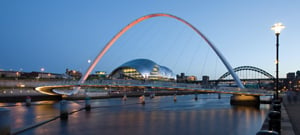Tapping into cultural tourism
Culture can play an important role in motivating people to make a visit. Lorna Easton explains how arts organisations can make the most of the opportunities this presents.

Britain’s culture and heritage attracts £4.5bn from international tourists – £500m of it spent directly at cultural and heritage attractions and events. Events, festivals, theatres, galleries and museums are all popular activities for tourists on holidays and short breaks – whether from the UK or overseas – which is why culture can help places to differentiate themselves. In the face of massive choice, towns, cities, counties and countries that want to attract tourists must be clear about what is special about the place – its ‘point of difference’. Yet too often we see the same old clichés being trotted out – surprising, original, cosmopolitan, diverse, unique mix, etc. It can be hard to identify those few key things which make a place different from everywhere else – and worth making a trip – but arts and culture can and do make a place look and feel different. They provide the distinctive experiences and authentic insights that can transform a tourist’s visit. And tourism offers new audiences for arts and cultural organisations and venues. Contributing to tourism can help them develop new partnerships, become part of a wider agenda and strengthen their business case.
In recent years we’ve seen a shift in the attitudes of both sectors and an appreciation of what the other can contribute, but there’s still a way to go: the perspective, priorities and outlook of the two sectors can be very different. Here are our top tips for how arts organisations can develop, sustain and exploit their relationships with the tourism sector.
Understand the differences. In many ways cultural tourists are no different to local audiences, but the way you reach them and talk to them will be different. They will undoubtedly know little, if anything, about you, and as you are unlikely to have the marketing budget to reach them directly you will need to work through others.
Do your homework. Find out who is responsible for tourism promotion and development in your area and who are the relevant chief executive and marketing director. Most agencies will have a corporate site so check out what they do, who they target, how they work with partners; then check out what they say about the destination on their consumer site. Some areas don’t have a ‘destination management organisation’ (DMO) and responsibility for tourism might lie with the local authority. If in doubt ask your local authority. Check out the national tourist boards’ corporate sites, which provide invaluable information about what they do, how they work with partners, routes to market, target markets and market intelligence – VisitEngland (www.visitengland.org), VisitScotland (www.visitscotland.org), VisitWales (www.wales.gov.uk/topics/tourism) and Visit Northern Ireland (www.nitb.com), as well as their consumer sites – www.visitengland.com, www.visitscotland.com, www.visitwales.com and www.discovernorthernireland.com. VisitBritain is responsible for marketing the whole of the UK internationally and, as culture is one of their main messages, it’s also worth checking them out at www.visitbritain.org (corporate) and www.visitbritain.com (consumer).
Sort your story. Find a way to talk about your organisation and offer which fits with how your DMO is promoting the place. This need only be a few sentences and a stunning photograph or two which capture what it would be like for a tourist to attend/visit what you have to offer. Use these with your tourist partners so they can easily fit your story into theirs.
Make friends. Meet with your DMO, tell them what you do and ask how you can help them and how you can work together. They may suggest you buy into their advertising opportunities but think about ‘in-kind’ support, things like hosting press trips they will be organising for travel writers: you might offer free tickets or behind the scenes tours.
Provide content. Local and national tourist boards are constantly looking for content to use in their promotion. You have got that content so use it. Identify stories and angles that fit what they are trying to do. Send newsworthy stories to their PR people, follow their blogs, Facebook activity and Twitter streams – and contribute, interact and engage.
Make more friends. People who meet tourists are an important route, so make friends with tourist information centre staff, hotel receptionists, taxi drivers and the like. Hold regular receptions at your venue and tell them about what you are doing. Show them a good time and they will recommend you to tourists asking for recommendations.
Collaboration. Make it easy for tourism bodies, have a bigger story to tell and a louder voice by working with your cultural colleagues to pull together a ‘what’s on’ of major events/happenings for the coming year. And give some thought to joint programming.
Be neighbourly. Remembering that tourists won’t know you and what’s around you particularly well, so identify other organisations or businesses you might work with in your vicinity that are likely to appeal to the same type of people and put together ‘mini-itineraries’. Think about how people might spend an afternoon or what they might do before and after visiting your venue – shop, eat, be entertained – and then promote these on all your websites, giving people reasons to visit and stay longer.
Join the Discussion
You must be logged in to post a comment.